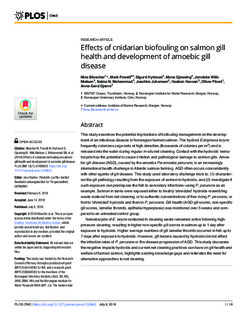| dc.contributor.author | Bloecher, Nina | |
| dc.contributor.author | Powell, Mark | |
| dc.contributor.author | Hytterød, Sigurd | |
| dc.contributor.author | Gjessing, Mona | |
| dc.contributor.author | Wiik-Nilsen, Jannicke | |
| dc.contributor.author | Mohammad, Saima N. | |
| dc.contributor.author | Johansen, Joachim | |
| dc.contributor.author | Hansen, Haakon | |
| dc.contributor.author | Floerl, Oliver | |
| dc.contributor.author | Gjevre, Anne-Gerd | |
| dc.date.accessioned | 2019-01-07T13:00:43Z | |
| dc.date.available | 2019-01-07T13:00:43Z | |
| dc.date.issued | 2018 | |
| dc.identifier.citation | Plos ONE. 2018, 13 (7), 18, e0199842. | nb_NO |
| dc.identifier.issn | 1932-6203 | |
| dc.identifier.uri | http://hdl.handle.net/11250/2579487 | |
| dc.description.abstract | This study examines the potential implications of biofouling management on the development of an infectious disease in Norwegian farmed salmon. The hydroid Ectopleura larynx frequently colonises cage nets at high densities (thousands of colonies per m2) and is released into the water during regular in-situ net cleaning. Contact with the hydroids’ nematocysts has the potential to cause irritation and pathological damage to salmon gills. Amoebic gill disease (AGD), caused by the amoeba Paramoeba perurans, is an increasingly international health challenge in Atlantic salmon farming. AGD often occurs concomitantly with other agents of gill disease. This study used laboratory challenge trials to: (1) characterise the gill pathology resulting from the exposure of salmon to hydroids, and (2) investigate if such exposure can predispose the fish to secondary infections–using P. perurans as an example. Salmon in tanks were exposed either to freshly ‘shredded’ hydroids resembling waste material from net cleaning, or to authentic concentrations of free-living P. perurans, or first to ‘shredded’ hydroids and then to P. perurans. Gill health (AGD gill scores, non-specific gill scores, lamellar thrombi, epithelial hyperplasia) was monitored over 5 weeks and compared to an untreated control group.
Nematocysts of E. larynx contained in cleaning waste remained active following high-pressure cleaning, resulting in higher non-specific gill scores in salmon up to 1 day after exposure to hydroids. Higher average numbers of gill lamellar thrombi occurred in fish up to 7 days after exposure to hydroids. However, gill lesions caused by hydroids did not affect the infection rates of P. perurans or the disease progression of AGD. This study discusses the negative impacts hydroids and current net cleaning practices can have on gill health and welfare of farmed salmon, highlights existing knowledge gaps and reiterates the need for alternative approaches to net cleaning. | nb_NO |
| dc.language.iso | eng | nb_NO |
| dc.publisher | Public Library of Science | nb_NO |
| dc.rights | Navngivelse 4.0 Internasjonal | * |
| dc.rights.uri | http://creativecommons.org/licenses/by/4.0/deed.no | * |
| dc.title | Effects of cnidarian biofouling on salmon gill health and development of amoebic gill disease | nb_NO |
| dc.type | Journal article | nb_NO |
| dc.type | Peer reviewed | nb_NO |
| dc.description.version | publishedVersion | nb_NO |
| dc.rights.holder | © 2018 Bloecher et al. | nb_NO |
| dc.source.pagenumber | 18 | nb_NO |
| dc.source.volume | 13 | nb_NO |
| dc.source.journal | Plos ONE | nb_NO |
| dc.source.issue | 7 | nb_NO |
| dc.identifier.doi | 10.1371/journal.pone.0199842 | |
| dc.identifier.cristin | 1596293 | |
| dc.relation.project | Norges forskningsråd: 233858 | nb_NO |
| dc.relation.project | Norges forskningsråd: 244444 | nb_NO |

